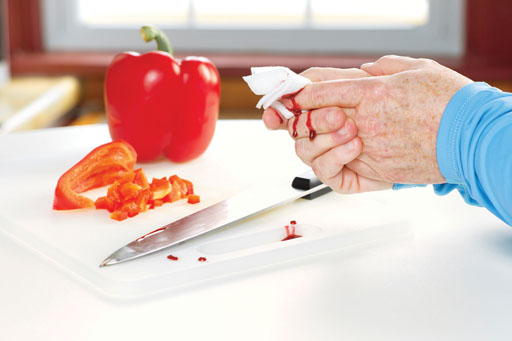Accidents will happen
In OTC
Follow this topic
Bookmark
Record learning outcomes
Community pharmacies can be the first port of call for patients with minor injuries so it's essential you're prepared.

According to the British Red Cross, 95% of adults are virtually clueless when it comes to first aid so their community pharmacy is a natural place to turn to for help and advice.
€I have treated patients on many occasions in my pharmacy consultation room,€ says Abraham Khodadi, aka YouTube's Abraham the Pharmacist. €Patients trust and rely on their pharmacies for help in these very situations which makes sense because 95% of the population in England has access to a community pharmacy within a 20 minute walk. During the summer holidays I tend to see many parents bringing in their children with cuts and grazes where I have cleaned the wound and dressed it appropriately. In some more serious cases I have referred people to A&E due to red flag presentations.€
From bandages and plasters to antiseptics and burn creams, it's essential that community pharmacies stock a range of products to help with the wide variety of minor injuries that present.
€When it comes to first aid products it's better to be over-prepared than underprepared,€ says Abraham. €Pharmacies should always stock the usual single item products such as plasters, burn creams and antiseptic wipes, but I find stocking first aid kits very useful for patients as they can contain a comprehensive collection of first aid items.€
Plasters
There is a wide range of different plasters on the market offering wound protection from antibacterial fabric plasters, containing antiseptic silver in the pad to prevent infection, to waterproof and easy removable products.
€There are many varieties of plaster available on the market to suit many consumer needs,€ says Sarah Dhillon, Elastoplast brand manager. €The optimum range is one that contains a balance of added benefit, classic and kids' plasters.€
Silver has featured heavily in the production of plasters because anti- bacterial silver ions are beneficial to the healing process when released into the wound exudate. It's also used in dressings for medium to large wounds.
Most people have experienced the pain of removing a plaster that's stuck fast, which is why Elastoplast has developed its innovative 'Silicone Soft' which promotes 100% pain-free removal, while offering reliable adhesion during use. These gentle plasters reduce discomfort as they don't strip the skin's epidermal cells or hair during removal thanks to a silicone adhesive. The plaster even sticks securely to the skin after it has been repositioned, making it ideal for people with fragile, irritated or sensitive skin.
Waterproof plasters should keep wounds dry when taking a shower, washing or bathing. However wash proof plasters, which are more commonly found in first aid kits, offer slightly less protection against water and the difference should be highlighted in the pharmacy.
Dressings
Most minor wounds can be treated at home with a simple dressing which has been specifically designed to stem the flow of blood and prevent bacteria-laden debris entering the area, potentially causing an infection.
€It is a good idea to have some wound dressings as well as plasters, because whether it's an accident chopping vegetables in the kitchen or using power tools during DIY, there's plenty of potential for more serious injuries in the home that can't be helped with a plaster,€ says Steven Pease, marketing executive of Safety First Aid Group.
Eye dressings are also essential stock items as well as eye wash and eye baths. Similarly a range of bandages to both secure wound dressings in place, as well as applying support and compression to sprains and strains too, are crucial.
Burns
There is a range of products available for minor burns from gels and sprays to creams and dressings. Specialist burn dressings have the ability to cool a burn just as effectively as water, removing the need to run the area under a tap for 20 minutes. This is particularly useful in hard to reach areas or when there isn't water readily available. These gel-soaked burn dressings cool the burn while soothing the pain. Available in a range of sizes, they also help to prevent contamination.
Burn Stop's range of products includes gels, sprays and dressings, which provide relief for minor burns, cuts and scrapes. Upon application the products begin cooling the skin helping to prevent the burn progressing further through healthy tissue. The gel also provides a protective barrier to guard against contaminants and irritants that could delay healing.
Pharmacists should also point out the benefits of other products to help with minor burns such as Sudocrem. This versatile cream provides gentle relief from cuts, grazes and minor burns as it helps to heal wounds by forming a protective layer. This reduces the risk of infection and the mild local anaesthetic it contains will soothe any discomfort.
Sprains and strains
It's advised that cold therapy should be used as soon as possible after a sprain or strain, with physiotherapists recommending the PRICE method €“ Protect, Rest, Ice, Compression and Elevation €“ for the first 72 hours after injury. However, as it is not always possible to stay still for long periods of time, and ice can only be used on skin for a maximum of 20 minutes, customers will be on the look-out for alternative options.

Products such as the Deep Freeze range from Mentholatum offer fast, effective cooling therapy that can be used whenever and wherever needed. These products provide lasting cooling relief, up to three centimetres deep.
€Cold therapy works in two ways,€ explains Kaye Mackay, senior brand manager for Deep Heat and Deep Freeze. €When cold is applied, it activates receptors in the skin, which send signals to the brain. These are sent along the same neurological pathway as pain signals and competes with them, so fewer pain signals get through and the sensation of pain is diluted.
€When cold is applied to an injured area, it causes the blood vessels in the soft tissue to constrict, restricting blood flow and limiting swelling and inflammation. This also helps reduce the amount of repair needed at the site of the injury.€
Applying ice to the affected area can help reduce pain and swelling, so offering customers a choice of reusable cold therapy packs is ideal. There is a range of products on the market which can be secured to the body with Velcro for ease of use.
Today, many people are looking for alternative treatments to help ease their injuries instead of heading straight for conventional pain relief. Essential oils and massage are proven to help relieve muscular pain, both of which are combined in the Puressentiel Muscles and Joints Roller. In fact, a clinical trial found that this device replicates the technique of deep transversal massage that physiotherapists use to treat painful tendons, ligaments and muscles.
€More and more I am asked for alternative natural remedies, as people are wanting to stay away from traditional painkillers,€ says Dan Jones, clinical physiotherapist and adviser to Puressentiel. €Combining evidence-based pure essential oils and massage makes sense from a scientific perspective because they both work to increase blood flow and relax muscle tissue and it's quite likely that there is a synergistic effect which amplifies this.€
Antiseptic
With Nielsen data revealing that antiseptic creams are only second in value to plasters in the first aid category, offering antiseptic creams is vital. They can treat a wide range of minor injuries, preventing infection.
€Customers want to be assured that the product they select will cleanse wounds and help prevent infection,€ explains Bernadett Khan-Gonda, Germolene brand manager. €Germolene Antiseptic Cream's dual action formula has antiseptic and anaesthetic properties which help to treat minor cuts and prevent infection.€
Available in a variety of sizes, Germolene numbs pain and helps to relieve the itching and irritation of minor skin injuries such as cuts and grazes, burns and scalds, as well as blisters, stings and insect bites. Additionally, the antiseptic (chlorhexidine digluconate) helps prevent secondary infection.
Whether customers are looking for something for a particular injury or a range of items to create their own first aid kit, community pharmacies need to offer a variety of first aid products to ensure that they are fully prepared for any minor emergency.
